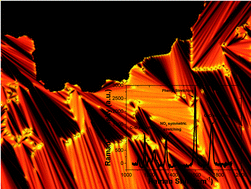Observing the emergence of phase biaxiality in a polar smectic A system via polarised Raman spectroscopy
Abstract
We report polarised Raman spectroscopy, and optical and dielectric properties of an asymmetric bent-core compound derived from 3-hydroxybenzoic acid with a long terminal chain at one end and a nitro group at the other. Earlier X-ray scattering experiments on the compound suggested a partial bilayer smectic A phase (SmAd) and a partial bilayer biaxial antiferroelectric smectic A phase (SmAdPA) in the material. The dielectric behaviour, the microscopic textures and conoscopy experiments all explicitly show that the compound exhibits two different phases, with the lower temperature phase biaxial in nature. Raman spectroscopy was used to determine the temperature evolution of the uniaxial order parameters 〈P2〉 and 〈P4〉, deduced from the analysis of the depolarisation ratio, informed by modelling the bent-core structure. Anomalously low values were measured (less than 0.5 and 0.15 respectively) which could suggest that the smectic A phase may be de Vries like in nature, rather than a partial bilayer structure. Raman spectroscopy was also used to investigate the biaxial nature of the SmAdPA phase. The effect that the biaxial order parameters 〈P220〉, 〈P420〉 and 〈P440〉 have on the depolarisation ratio is calculated. By making the assumption of an approximately continuous increase in the 〈P2〉 and 〈P4〉 order parameters, it was possible to deduce the behaviour of the biaxial order parameters in the biaxial SmAdPA phase; the emergence of biaxial order in the system is clearly demonstrated as all of the biaxial order parameters increase in magnitude as the temperature decreases in the (SmAdPA) phase. The dielectric studies show that the perpendicular component of the dielectric permittivity increases from 10 to 70 in the SmAd phase and decreases from 70 to 45 in the SmAdPA phase. A strongly temperature dependent relaxation frequency with a large value of ∼400 kHz is observed in the SmAd phase. On the other hand, the SmAdPA phase exhibits a weakly temperature dependent relaxation frequency at ∼100 kHz.



 Please wait while we load your content...
Please wait while we load your content...